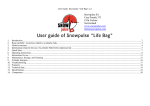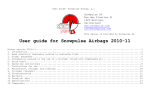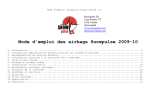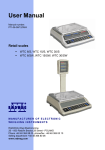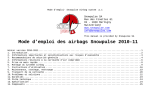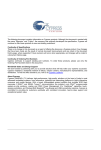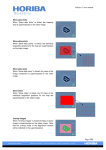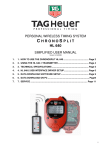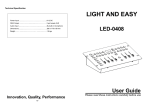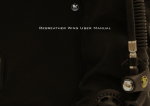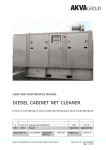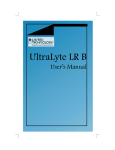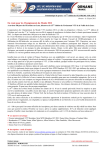Download User guide of Snowpulse airbags 2009-10
Transcript
User Guide- Snowpulse airbag. p.1 Snowpulse SA Case Postale 373 1936 Verbier Switzerland www.snowpulse.com [email protected] User guide of Snowpulse airbags 2009-10 1. Introduction ........................................................................................ 2 2. Read carefully: Awareness related to avalanche risks ................................................ 3 3. Global awareness .................................................................................... 4 4. Information related to the use of a cylinder filled with compressed air ............................. 5 5. Quick Start ......................................................................................... 7 6. Operating instructions .............................................................................. 8 7. Instructions for use ............................................................................... 14 8. Maintenance, Storage, and Cleaning ................................................................. 16 9. Cylinder transport ................................................................................. 17 10. Troubleshooting .................................................................................... 19 11. Warranty ........................................................................................... 20 12. Technical data ..................................................................................... 21 13. Specifications ..................................................................................... 21 14. Components ......................................................................................... 22 User Guide- Snowpulse airbag. p.2 1. Introduction Congratulations on your purchase of the Snowpulse Airbag. Airbags provide you a greater degree of safety in the mountains without compromising the weight or volume of your backpack. Avalanches kill people each year. The Snowpulse airbag will increase your chances of survival; however the Snowpulse airbag does NOT guarantee your safety during an avalanche. Snowpulse airbags are rescue devices, like avalanche beacons, avalanche probes, and avalanche shovels. You must not take more risks just because you have a Snowpulse airbag! Snowpulse airbags have 2 main purposes: 1. The first one is to keep an avalanche victim on the surface, facing upward with the head above the Snow. This is possible using the inverse segregation, a phenomenon that results in the bigger particles of a fluid in motion being on the surface after a certain amount of time. To be efficient, avalanche airbags need be sweep along within the avalanche flow. 2. The second purpose is to protect the head and the thorax during an avalanche. Trauma protection is provided as soon as the airbag is inflated. To ensure the efficiency of your airbag, it is important that the airbag is deployed as soon as you are caught in an avalanche or believe you may be caught in one. The airbag system, developed by Snowpulse SA, has several key innovations: A floatation Head On Top which encourages an upward facing position with the head above the snow Protection of the head and thorax (15-20% of avalanche deaths are due to trauma) A light and compact system A quick-fastening buckle An easy-to-reuse system without having to return your product. A possibility of refill/exchange of the air cylinder (see conditions within this manual) The correct use of the Snowpulse Airbags relies on the system being in good condition and the user being trained. The handling and instructions provided within this user guide should be carried out carefully. User Guide- Snowpulse airbag. p.3 2. Read carefully: Awareness related to avalanche risks Read before use. Do not throw away instructions: Snowpulse airbags cannot prevent avalanches. An avalanche always presents a risk of death or injury, with or without an airbag. The Snowpulse Company is not liable for any injury or death resulting from an avalanche. Any person practicing an activity and using a Snowpulse airbag agrees to do so at his own risk. The use of a Snowpulse airbag should not increase the risks taken. The best protection from an avalanche is to not put yourself in avalanche terrain. If in doubt, do not proceed. The Snowpulse airbag attempts to hinder victim burial, among other things. There are, however, situations in which the effectiveness of the airbag could be limited, and burial is possible. The Snowpulse airbag does not offer any assistance in searching for a victim completely buried by an avalanche. Searching for a buried victim is only possible using an avalanche transceiver. . The Snowpulse airbag is a safety supplement, such as an avalanche transceiver, probe, and shovel. These various tools are complementary and essential for safe backcountry travel The Snowpulse airbag must be deployed by the user himself. Users should train themselves and simulate pulling the handle in order to react quickly and effectively in the event of an avalanche. Snowpulse airbags require maintenance and proper storage. The overall condition of the system should be checked before each outing, following the instructions contained in the chapter, “Quick start Snowpulse”. Snowpulse airbags and their backpacks are approved in accordance with the EC Directive 89/686 for PPE by the TÜV SUD Product service, Riderstr.65, D-80339 München, control n° 0123. User Guide- Snowpulse airbag. p.4 3. Global awareness Read before use: All of the straps and components of the airbag have a role in the functioning of the airbag system should an avalanche occur. The straps and the buckles integrated into the airbag create a harness around the user and are an integral part of the bag in order for it to function correctly. Do not change the buckles or straps on the bag as it may result in a weakening of the product and as a result the airbag being ripped from the user during and avalanche. Do not attempt to dismantle or modify any part of your airbag which is not described in the user manual. Any modification which is not described in the user manual can damage the system and put the user in jeopardy. Internal repair and trouble shooting must be done by a Snowpulse retailer. Any modification can void the warranty of the Snowpulse pack. To ensure proper functioning of the airbag the waist buckle, chest buckle, and leg strap must be fastened correctly every time you put it on. Ensure that all straps are snug around the user. In order to close the leg strap, slide the waist strap through the leg strap’s buckle. Failure to use the leg strap may result in the Snowpulse rising up on the user during an avalanche which may lead to the chest strap choking the user. Ensure that all zippers are completely closed. It is very important that the zipper which runs over the shoulder of the user (and that closes the cover containing the airbag) is zipped all the way and the slider is at the very bottom of the shoulder strap Keep the Snowpulse airbag out of reach of children. The airbag contains a cylinder of compressed air which poses a serious threat to a child or user if not treated properly. The airbag has been designed for 20 airbag deployments. Once it has been deployed 20 times it needs to be returned to the retailer to perform a check on the internal components of the airbag. If the airbag gets wet, unfold the airbag to dry it out, and repack it once dry using the procedures outlined in the manual. This is important as a wet airbag can freeze and affect the deployment of the airbag. The airbag system must only be used to increase survival chances in the case of an avalanche. It is dedicated to winter activities in back country. The airbag should not be inflated on ski resort slopes as people may be surprised by its inflation and loose control. Inflated, the airbag reduces the field of vision. Trigger of the airbag should therefore be done when this reduction does not represent a risk. User Guide- Snowpulse airbag. p.5 4. Information related to the use of a cylinder filled with compressed air 4.1. Awareness The airbag system uses a cylinder filled with compressed air. Improper handling of the cylinder could result in the cylinder exploding and raises a potential threat of injury or loss of life. Improper handling can also damage the airbag and its cylinder Please use the following rules: The release mechanism on the top of the cylinder must not be manipulated or dismantled. Manipulation of the release mechanism (= cylinder valve) during a cylinder refill must only be done by trained individuals. Refill must be done by people having be officially trained and following the instruction provided during the training. Do not throw or damage the cylinder with tools (hammer, grips, etc…) Never expose the cylinder to heat (stove, direct sunlight, etc…), maximum temperature 50°C If you have an extra cylinder, or your cylinder is not installed in your airbag, keep it in its original packaging, with yellow thread protectors on, in a dry, cool, place. If you wish to mail a pressurized cylinder the carrier must be informed and all rules and regulations followed (as well for the destination country). Cylinders must be mailed only in their original package with their 2 yellows caps. See chapter 9 for more information. The cartridge can only be used if the 2 red tapes are on place and in good state. Those tapes avoid any water infiltration in the mechanism. User Guide- Snowpulse airbag. p.6 4.2. Working pressure The work pressure of your cartridge is marked on it. The Snowpulse airbag is designed to work at temperatures between -30 C and + 50C. The pressure gauge on the top of the cylinder allows you to simply and continuously monitor the cylinder pressure. To function properly the cylinder is designed to be filled at 20°C (= 68°F), at which point the gauge needle should be in the “green” zone. At very cold temperatures the pressure needle will remain in the “blue” zone, and at high temperatures within the “red” zone, A cylinder with a pressure of 3’000 PSI (American Cylinder) or 300 bar (European Cylinder) at a temperature of 20°C will ensure proper inflation of the airbag for temperature range of -30°C +50°C. A pressure below at 20°C will result in incomplete inflation of the airbag and will not provide the user any protection. Variations in temperature will change the pressure of the cylinder. At cold temperatures, it’s normal that the gauge needle is in the blue area indicating a pressure lower than that checked at 20°C. This does not alter the function of the airbag. Do not use if the pressure is over 3100 PSI (American Cylinder) or 310 BAR (European Cylinder) at 20°C as it could damage the system and injure the user. 4.3. Cylinder Exchange/Refill After your airbag has been deployed the cylinder will need to be refilled. You can have your cylinder refilled or exchanged for a full one at several Snowpulse retailers and at specific dive shops throughout North America. Only individuals who refill the Snowpulse customers. Once the (compressor or scuba www.snowpulse.com for have gone through the training with a Snowpulse representative are authorized to cylinders. The training is available to all organizations, as well as individual training is completed the user will require a source of dry compressed air tank) and specific attachments to refill the Snowpulse cylinders. Please visit more information. User Guide- Snowpulse airbag. p.7 5. Quick Start This quick start is intended to give you a brief introduction into the features of the Snowpulse airbag system needed to get started. To ensure the proper functioning of your airbag, it must be checked after purchase and thereafter prior to each outing. We also recommend that you carefully read the complete User Manual. 1. Check that the zip on the shoulder straps (which contains the airbag) and its Velcro patch are completely closed. 2. Check to ensure that all mechanical components are tightened. 3. Check the air cylinder pressure. 4. Check that the handle is correctly connected to the cylinder release pin. 5. Check that the cylinder is securely attached and that there are no objects jamming the air channels. 6. Before entering avalanche terrain, unzip the release handle from its pocket. Ensure that the chest strap does NOT go through the handle, and should the need arise the handle is in a good pulling position. 7. Do up your chest and waist buckle as well as the leg straps. 8. In case of an avalanche firmly pull the handle. User Guide- Snowpulse airbag. p.8 6. Operating instructions System assembly can be carried out upon receiving the product, but also following its use, whether in the case of trial or actual avalanche. 6.1. Attaching the cylinder within the Snowpulse airbag: 1. Check the cylinder Check the pressure as outlined in Chapter 4 and ensure that the cylinder appears in good condition. 2. Check that all cylinder components are tight User Guide- Snowpulse airbag. p.9 3. Check straps and buckles Ensure that all straps and buckles, including the ones holding the cylinder, are in good shape. This should be checked on a regular basis throughout your trip. 4. Trigger cable check Ensure that the handle is secured to the release cable and that the release cable passes freely through the outlined slit. Check also that the cable slides freely within the hose 5. Airbag folding (this is unnecessary upon receiving the airbag) Follow the instruction and pictures contained in chapter 6.2. Folding of the airbag is required after deployment of the system (either for training purposes or in the case of an avalanche), if the airbag has not been deployed in more than 1 year, or if you suspect that the airbag is wet or moist. To avoid jamming the fabric while closing the zip, put your finger between the zip and the airbag fabric. User Guide- Snowpulse airbag. p.10 6. Closing of the airbag cover (unnecessary upon receiving the airbag) Following a total or partial opening of the cover (unwished or due to airbag inflation), continue to completely undo the zipper. At this point bring the zip slider back to the start of the zipper next to the handle .Then close the sleeve of the airbag again. The zip has to be closed all the way. For more details, see chapter 6.2. 7. Attaching the cylinder into the box. Unscrew the 2 yellow thread protectors of the cylinder. Screw the cylinder onto the black box until the end of the threads, and then unscrew slightly if necessary, so that the filling connector is on your right and the gauge is facing you. Do not unscrew more than one turn. If tightening is met with abnormal resistance just clean the aluminium screw thread with an oiled tissue and try again. In case of problem contact your Snowpulse retailer. 8. Attaching the release cable Warning: Use caution when attaching the cable to the release pin so that you do not accidentally deploy the airbag. Screw the cable onto the release pin. Some resistance may be felt due to thread sealant on the pin. The connector must be screwed on 5mm and tightened well. User Guide- Snowpulse airbag. p.11 9. Attaching the cable hose connector onto the opening mechanism The cable hose connector should be tightened securely onto the opening mechanism. This prevents any moisture entering the system, which could ice up and cause a malfunctioning. Check if there are still threads left after tightening 10. Fastening the cylinder to the backpack: Fasten the cylinder using the Velcro patch within the backpack. Zip up the mesh pocket containing the cylinder. 11. Attaching the Handle Use the Velcro to attach the handle. Wear and tear of the Velcro may mean that the handle has been poorly fastened. When transporting or storing your Snowpulse bag, zip the handle into the pocket. Be sure to take it out of the pocket before you proceed into the backcountry. 12. Check following Quick Start (Chapter 5) Do a last check following instruction of chapter 5. Congratulation, your airbag is now ready to use User Guide- Snowpulse airbag. p.12 6.2. Airbag Folding Instructions 1. The folding of the airbag will be necessary after a deployment, if the airbag has got wet, been stored for more than one year, or if the zipper starts to come apart. To avoid jamming the fabric while closing the zip, put your finger between the zip and the airbag fabric. You do not want to roll the airbag. A refolding video can be found on the CD provided or on www.snowpulse.com. Push the long nylon rod inside your pack into the metal cone located above the cylinder. Keep this in place for the next few steps. 2. Ensure that the zip covering the airbag is completely apart. Bring back the zip slider to the end. This is possible once the zip is completely split apart. To split apart the zip, ensure the zip slider is at the end of the zip and gently pull on the 2 sides of the zip. 3. Place the pack down with the shoulder straps facing up. The airbag has four seams, align the top two with the bottom two. 4. Fold up the end of the airbag. Fold the sides in, starting with the side closest to the centre. Take care not to roll the sides in. Use the provided hook to keep the airbag folded. Zip up the first 2030cm. To avoid jamming the fabric while closing the zip, put your finger between the zip and the airbag fabric. 5. Fold up the top of the airbag 6. Push the top of the airbag into the mesh pocket contained at the top of the pack. Again be careful not to roll the airbag. Zip the cover closed placing a finger underneath the zipper to avoid jamming of the airbag fabric. The hook holding the airbag folded has to be taken off now in order to close the zipper all the way around, ensuring that the zipper is completely closed. 7. Remove the nylon rod used to deflate the airbag. User Guide- Snowpulse airbag. p.13 User Guide- Snowpulse airbag. p.14 7. Instructions for use 7.1. Adjusting the airbag to fit Using the various straps adjusts the bag to properly fit your body. It is very important that the Snowpulse airbag remains attached to the victim during an avalanche, and to do this all straps and buckles should be well fastened. The three main attachment points are the chest strap, waist belt, and leg strap. See the “Quick Start” portion of this user manual for figures. Snowpulse backpacks are designed to fit individuals of various sizes. They are available in Medium and Long sizes, and 10L, 15L, 30L, and 45L volume packs. If the airbag does not fit your body, you should not use it. 7.2. Take care to avoid getting dust on the mechanical parts The interior of the bag should not contain any loose, small particles such as bread crumbs and chips which could limit the effectiveness of the system when it is deployed. Take care to avoid getting dust, food, etc on the mechanical parts within the backpack. 7.3. Use of the release handle pocket The release handle should always be stored in its pocket when you are transporting or not using the pack. This includes travelling on a ski lift or helicopter. This is to avoid unwanted deployment of the Snowpulse. Ensure that you open up the handle before entering avalanche terrain. User Guide- Snowpulse airbag. p.15 7.4. Carrying Skis, a snowboard, and other Gear All of the outside straps on the airbag can be used to carry gear. However it is very important that the cover containing the airbag and located at the top of the pack is not blocked. Also take care not to carry any sharp objects on your shoulder. The shoulder straps of the bag have been reinforced so that it is possible to carry skis over your shoulders, however the skis should be carried flat, not on their edges. If the black fabric containing the airbag has been cut, check carefully that the airbag fabric has not been damaged. The airbags allow you to carry skis on the side or diagonally on your pack; snowboards are carried vertically. User Guide- Snowpulse airbag. p.16 7.5. Use of the system in the event of an avalanche In the event that you believe you are about to be caught in an avalanche deploy the airbag as soon as possible by pulling the trigger handle. The airbag inflates in approximately 2-3 seconds and makes a significant amount of noise. If you are able to do so, try to reach a safe location to avoid getting caught. It takes approximately 6Kg (13lbs) of force to deploy the airbag. After the airbag is deployed push the nylon rod inside the airbag through the hole located under the venturi box to completely deflate the airbag. Push the pin through the netting towards the interior of the airbag via a hole of the diffuser and then deflate the airbag. Once the airbag is deflated, fold the airbag as explained in this document. Once the airbag is folded and its cover closed, remove the tool used to deflate it. Poor folding or folding a wet airbag could cause malfunction of the system and/or damage it. After use of the system in a real avalanche, check all parts of the airbag to detect and identify any damage. Contact your retailer to evaluate if your airbag should be returned to the factory for quality control testing. A full cylinder now needs to be installed. The Snowpulse airbag cylinder is good for 1 deployment only before it needs to be refilled and serviced. 8. Maintenance, Storage, and Cleaning 8.1. Maintenance required annually or after moisture has penetrated the airbag. Unfold the airbag to let it dry completely and refold it once it is completely dry. Check all cables and attachment points to make sure they are secure and in good condition. Check the overall condition of the airbag by following the checks outlined in the chapter “Quick start Snowpulse”. 8.2. Checks after an avalanche Checks after an avalanche must be carried out with a great prudence since the airbag and the Snowpulse system could be seriously damaged or unusable. The airbag seals must be checked to avoid any risk of rips or tears which could leak. . Visual monitoring is essential to assess the general condition of the system (seams, straps, and mechanics). It is strongly recommended that you send your backpack to a Snowpulse retailer for a complete system check. User Guide- Snowpulse airbag. p.17 8.3. Checks of your airbag after 20 deployments The airbag mechanism has been designed to allow 20 deployments (either for training or for real use). Any Snowpulse airbag which has been deployed 20 times is required to be sent back to the Snowpulse dealer for a complete check of the product. 8.4. Storage and cleaning of your airbag Keep the Snowpulse bag out of reach of children. The airbag and its cylinder of air under pressure can create serious injury to child or user Store the Snowpulse bag in a dry, cool place. Cylinders not installed in the airbag must always be stored in its original packaging with the yellow thread protectors on Clean the Snowpulse bag with water only, do not use any solvents. Be sure not to stress the bag or put heavy loads on it during transport. 9. Cylinder transport 9.1. Air transport according to the International Air Transport Association (IATA) For any shipment, the 2 yellow thread protectors must be in place. The cylinder must always be shipped within the Snowpulse pack or in its original packaging. According to the International Air Transport Association (IATA); Transport of a Snowpulse airbag with a European (300 bar) cylinder under pressure is allowed for private purpose but it is required that you declare the airbag before check-in. (norm OACI under the description of « Avalanche Rescue Backpack » reference: IATA-DGR. Table. 2.3. A). Despite air transport of the European cylinder is allowed regarding the IATA worldwide regulation, you must follow the regulation of your country; the European cylinder is for example not allowed in Canada nor USA. Following status of the regulation in 2008, the airbag sold in Europe with its 300 bar cylinder is accepted for air transport all over Europe Transport of a Snowpulse airbag with an American (3000 PSI) cylinder under pressure is regulated and is allowed only for transport linked to rescue missions (and that for any country). Only in Canada the User Guide- Snowpulse airbag. p.18 transportation of a Snowpulse airbag with the American Cartridge is allowed for air transportation as the system is classify as UN2990 LIFE-SAVING APPLIANCES, SELFINFLATING. This includes heli-skiing activities. In other countries it is always possible to empty the cylinder by triggering the airbag. In fact, an empty cylinder is allowed. Never try to empty a cylinder by any other means than deploying the airbag using the trigger handle. 9.2. Cylinder shipment Freight companies must be made aware of the content of your shipment. It is your responsibility to respect the regulations within your country. In most cases it is required that if you are shipping a full cylinder it must be properly labelled as a dangerous good. Below is a list of information which your carrier may require. Snowpulse cylinders are a dangerous good according to the European Agreement concerning the International Carriage of Dangerous Goods by Road (ADR). ONU official number : UN 1002 Official designation : Compressed air, 2, Official label : 2.2 Classification : 2 Small quantity notification : Exemption : Transport not overpassing free limits described in chapter 1.1.3.6". User Guide- Snowpulse airbag. p.19 10. Troubleshooting 10.1. The airbag is not completely inflated. Your airbag should be completely inflated when you pull the handle, and then over several minutes it should slowly deflate. This is normal if the airbag does not fully inflate there are several possible reasons: The airflow within the venturi box may be blocked. For the Snowpulse to work properly air must be able to freely pass through the air channel and diffuser. Make sure the internal mechanical components are free and not jammed. The mesh pocket containing the cylinder must never be used to store anything else. Check The cylinder pressure may be to low. A pressure below 3000PSI (American cylinder) or 300bar (European cylinder) for a cylinder at 20°C (=68°F)does not allow a complete inflation of the airbag. The pressure of your cylinder must be checked at 20°C. Check that no objects are blocking the airflow in the back air channel. The zip of the cover containing the airbag must be completely closed with its slider at the end of the zip, on the handle side. 10.2. Nothing happens when you pull the handle: Check that the cable is linking the handle to the release. Check both end of the cable are attached and in good condition. Check that the cylinder is not empty as indicated by the gauge. Check that the cable hose is securely fastened to the cylinder. To trigger the airbag, it’s necessary to pull the cable with a force of approximately 6Kg (13lbs). Pull the handle in front of you rather that pulling down, the Velcro attaching the trigger handle should release.. If this does not solve the issue, return your Snowpulse airbag to the retailer with your receipt. The retailer will send the product to the distributor or to Snowpulse directly. User Guide- Snowpulse airbag. p.20 11. Warranty This Snowpulse airbag has been extensively tested and researched, every detail has been looked at. The materials used are the most suitable for their intend use and a stringent quality control system helps to reduce the possibility that your airbag has any defects. Should you come across defects anyway, the airbag comes with a 3 year or 100 days of use warranty. The guarantee does not cover defects caused by improper use or normal wear and tear of parts following prolonged use. The purchaser must return the faulty item to the point of sale where the purchase was made along with the proof of purchase (a condition required for the validity of the guarantee) The retailer will forward the item to the distributor or directly to Snowpulse Snowpulse will, at its discretion, replace or repair the item. If the defect is not covered by the warranty, repairs will be carried out at a low cost, inclusive of shipping or postage. This guarantee does not affect the consumer’s statutory rights, as specified by the laws in force in the country of use. Warning : The airbag mechanism has been designed to allow 20 deployments of the airbag (either for training or real use). It is mandatory that your Snowpulse retailer do a complete check of your product after 20 deployments. User Guide- Snowpulse airbag. p.21 12. Technical data Temperature range: Airbag volume: -30°C to 40°C 150 litres Weigth 15L, 30L 45L: 3 kg +/- 300g (without cylinder: 2.4kg) Gas: breathable air (dry) Inflation time: 3 sec (function of elevation and temperature) Cylinder pressure: see its label 13. Specifications Type: Snowpulse Airbag Manufacturer: Snowpulse SA, Place de Savoleyres, Case Postal 373, 1936 Verbier, Country manufacture: Switzerland CE: directives PPE 89/686 Notified body : TÜV Sud Produkt Service Ridlerstr.,65 D 80339 München Notified body N°0123 User Guide- Snowpulse airbag. p.22 14. Components No. 1 2 3 4 5 6 7 8 9 10 11 12 13 14 15 16 17 18 19 20 21 22 23 24 25 26 27 28 28 Description Cylinder frame Gaz cylinder Cylinder O-ring Piston Piston O-ring Ring of piston Support piston Lever Release pin Pin for lever Tightening ring Connect Cable Quick connector Piston quick disconnect Quick connector O-ring Filter Diffusor Conduit Valve Valve Ring Ring 2nd Ring Ring to tight diffusor Diffusor rubber Hose connector Hose Cable Spring Venturi Box User Guide- Snowpulse airbag. p.23 No. Description 1 Trigger cable 2 Velcro to anchor the trigger handle 3 Trigger Handle 4 Cover zip's 5 Handle pocket 6 Cover over zip gap 7 Chest Buckle 8 Air input 9 Air input 2 10 Waist buckle 11 Leg strap 12 Hose-Cylinder connector 13 Venturi Box 14 Release pin connector 15 Cylinder pocket 16 Tool to deflate airbag This symbol means that the user guide must be read before this backpack is used. END OF DOCUMENT























